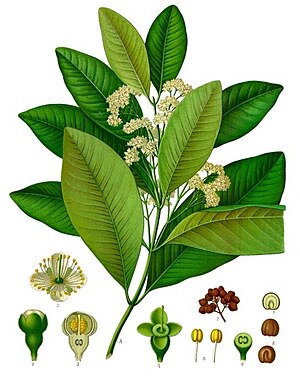Pimenta (genus)
| Pimenta | ||||||||||||
|---|---|---|---|---|---|---|---|---|---|---|---|---|

Allspice ( Pimenta dioica ), illustration |
||||||||||||
| Systematics | ||||||||||||
|
||||||||||||
| Scientific name | ||||||||||||
| Pimenta | ||||||||||||
| Lindl. |
Pimenta is a genus of plants inthe myrtle family (Myrtaceae). Spices and essential oils are obtainedfrom at least two types.
description

Vegetative characteristics
Pimenta species are evergreen trees . The against-constantly arranged on the branches leaves are usually divided into petiole and leaf blade. The leathery leaf blades are simple and have entire margins.
Generative characteristics
The flowers stand together in zymous inflorescences . The cream-colored to white flowers are radial symmetry . Two - seeded berry - like stone fruits are formed.
Systematics and distribution
The genus Pimenta was established by John Lindley . Synonyms for Pimenta Lindl. are: Amomis O.Berg , Cryptorhiza Urb. , Evanesca Raf. , Krokia Urb. , Mentodendron Lundell , Myrtekmania Urb. , Pimentus Raf. , Pseudocaryophyllus O.Berg .
The distribution areas of the species are in the Neotropic . With around seven species, Cuba is the center of biodiversity. Some Cuban species are threatened with extinction.
The genus Pimenta contains 12 to 15 species:
- Pimenta adenoclada (Urb.) Burret : The home is Cuba.
- Pimenta cainitoides (Urb.) Burret : The home is Cuba.
- Allspice ( Pimenta dioica (L.) Merr. ): It is distributed from southern Mexico to Central America and on the Caribbean islands.
- Pimenta ferruginea (Griseb.) Burret : The home is Cuba.
- Pimenta filipes (Urb.) Burret : The home is Cuba.
- Pimenta guatemalensis (Lundell) Lundell : It is common in Guatemala, Costa Rica and Panama.
- Pimenta haitiensis (Urb.) Landrum : The home is the southern Hispaniola.
- Pimenta jamaicensis (Britton & Harris) Proctor : The home is Jamaica.
- Pimenta obscura Proctor : The home is Jamaica.
- Pimenta odiolens (Urb.) Burret : The home is Cuba.
- Pimenta oligantha (Urb.) Burret : The home is Cuba.
- Pimenta podocarpoides (Areces) Landrum : The home is Cuba.
-
Pimenta pseudocaryophyllus (Gomes) Landrum : The three varieties are common in Bolivia and Brazil:
- Pimenta pseudocaryophyllus var. Fulvescens (Mart. Ex DC.) Landrum : It occurs in Bolivia and Brazil.
- Pimenta pseudocaryophyllus var. Hoehnei (Burret) Landrum : It occurs in southern Brazil.
- Pimenta pseudocaryophyllus var. Pseudocaryophyllus : It occurs in southern Brazil.
-
Pimenta racemosa (P.Mill.) JWMoore : The five varieties are distributed from the Caribbean island to Venezuela:
- Pimenta racemosa var. Grisea (Kiaersk.) Fosberg : It occurs from the Dominican Republic to the Virgin Islands .
- Pimenta racemosa var. Hispaniolensis (Urb.) Landrum : It occurs on Hispaniola.
- Pimenta racemosa var. Ozua (Urb. & Ekman) Landrum : It is endemic to the north-central Hispaniola.
- Pimenta racemosa (P.Mill.) JWMoore var. Racemosa : It is distributed from the Caribbean island to Venezuela.
- Pimenta racemosa var. Terebinthina (Burret) Landrum : It is endemic to the northeast Dominican Republic.
- Pimenta richardii Proctor : The home is Jamaica.
literature
- LR Landrum: Campomanesia, Pimenta, Blepharocalyx, Legrandia, Acca, Myrrhinium, and Luma (Myrtaceae). In: Organization for Flora Neotropica, ed., Fl. Neotrope. Monogr. 45:88, 107, 111, 1986.
- H. León, H. Alain: Flora de Cuba. , 5 Tomos y Sublimento. Havana, 1946-62.
Individual evidence
- ↑ [1] and [2] in IUCN Red List of Threatened Species.
- ↑ a b c d e f g h i j k l m n o p q r s t u v w Rafaël Govaerts (Ed.): Pimenta. In: World Checklist of Selected Plant Families (WCSP) - The Board of Trustees of the Royal Botanic Gardens, Kew . Retrieved June 4, 2017.
